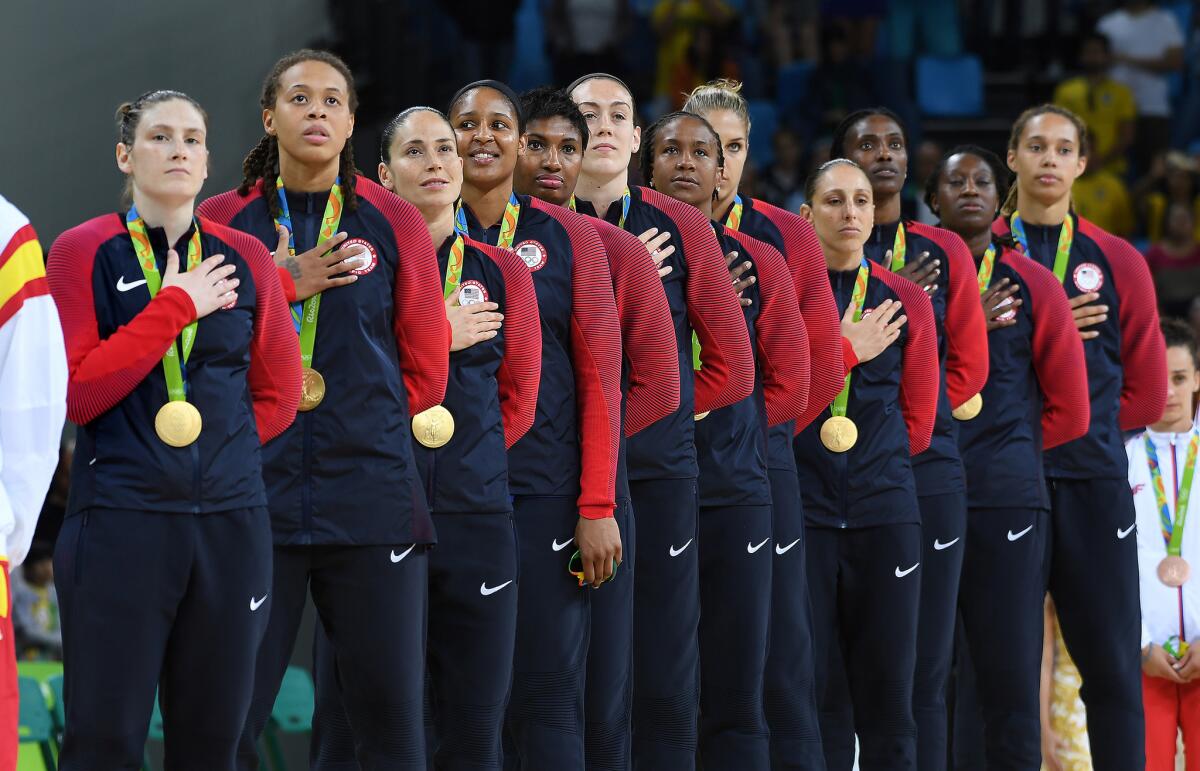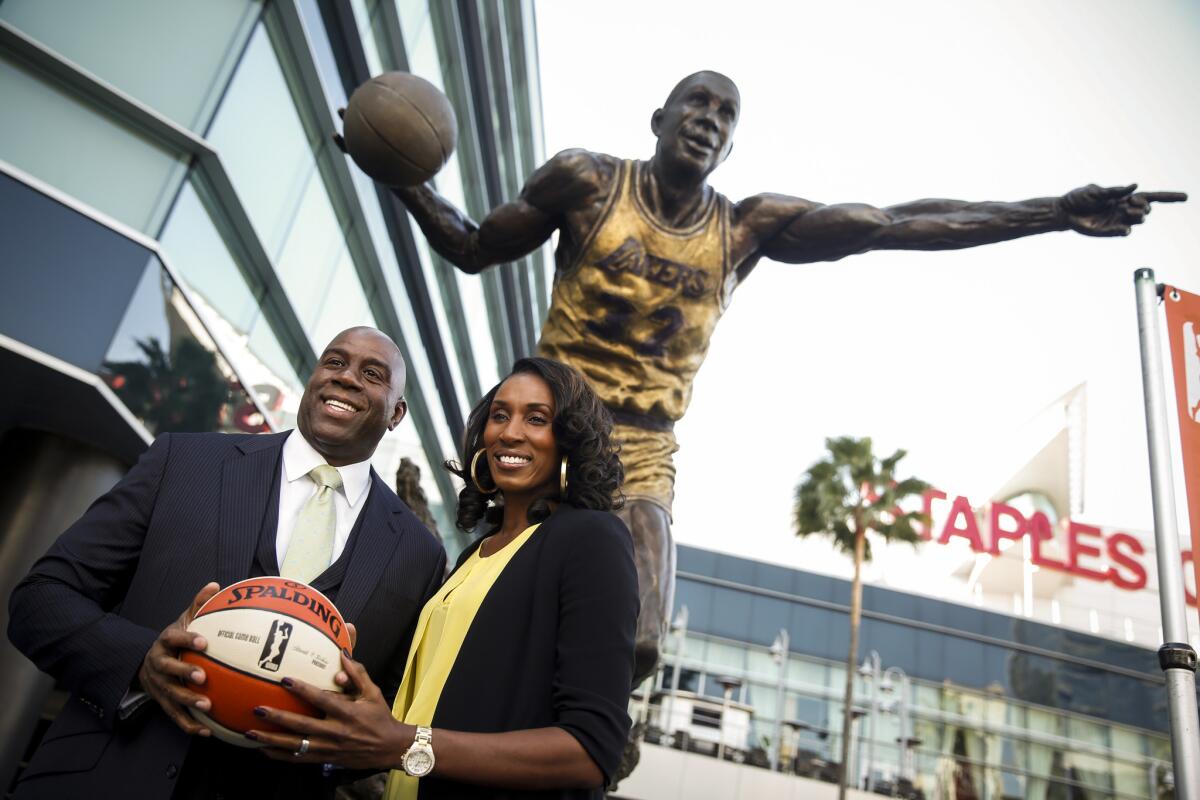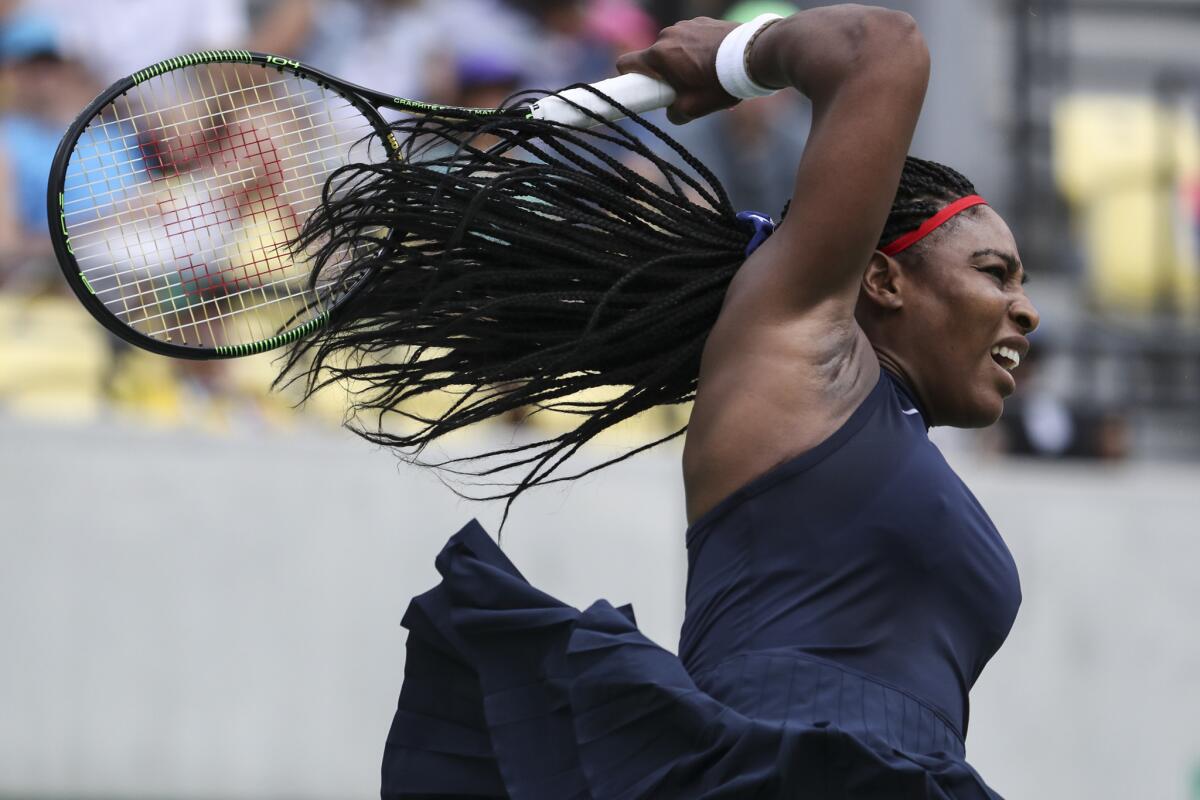Women’s pro leagues like the WNBA and NWSL seek post-Olympics bounce, but it’s no slam dunk

- Share via
Of the 558 American athletes at the Olympic Games in Rio de Janeiro, a record 294 were women.
Among the most dominant were the 12 women basketball players who on Saturday won an unprecedented sixth consecutive gold medal for the U.S. in the sport. Another high-profile group: the 18 players on the U.S. women’s soccer team, the defending World Cup champs, who unexpectedly lost in the quarterfinals in Rio.
Post-Olympics, those 30 elite female athletes will return to their professional leagues, the WNBA and the National Women’s Soccer League. And millions of viewers who watched them on TV at the Olympics will largely forget and move on.
Women’s professional sports continue to garner only a tiny fraction of the attention, TV ratings, advertising and salaries that men’s sports generate in the U.S.
The Olympics aren’t the only competition in which the audience exhibits sudden-onset gender blindness. The 2015 Women’s World Cup final between the U.S. and Japan was viewed by nearly 27 million Americans, the most-watched soccer match in U.S. history.
But a domestic women’s professional league has yet to convert some peak moments of visibility into a sustained, profitable success.
You don’t ever imagine what you worked so hard to build could disappear overnight.
— Lisa Leslie

Former Sparks star Lisa Leslie poses with Magic Johnson beneath the statue of Johnson before the start of a news conference to announce the purchase of the Sparks WNBA team by the investment group led by Johnson and Mark R. Walter on Feb. 5, 2014.
“I never really thought about the vulnerability of the [WNBA] until I saw the Sparks almost go under in 2014,” former Sparks star Lisa Leslie wrote for The Players’ Tribune website in May. “You don’t ever imagine what you worked so hard to build could disappear overnight.”
Since the WNBA’s first season in 1997, six teams have folded, four have relocated due to financial strain and the Sparks, one of only three franchises left from the original eight, lost $12 million over seven years before Magic Johnson and his investment group bought the team in 2014.
“We need to grow — not just scrape by — for the next 20 years,” Leslie wrote about the WNBA.
The WNBA’s average attendance hit a record low of 7,318 fans last year. Lisa Borders, in her first year as league president, said one of her long-term goals is to fill every arena for every game. Attendance is up 2.7% so far in 2016, she said.
“It’s a cultural perception that . . . whatever game we’re talking about, women don’t play it as well as men,” Borders said. “People’s perception becomes reality when they’re not informed and have never seen a game. It’s like having an opinion on a restaurant without ever having eaten there.”
On the TV front there is some good news. ESPN is paying the WNBA $12 million this season for broadcast rights, according to Sports Business Daily, and that jumps to $25 million next year. The first eight WNBA games broadcast on ESPN channels this year averaged a modest 208,000 viewers.
All this starkly contrasts with the NBA’s nine-year TV contract with ABC, ESPN and TNT worth $2.7 billion annually, starting with the 2016-17 season. Value is tied to popularity — and the Cavaliers-Warriors NBA Finals in June averaged 20.1 million viewers for ABC, the highest for a Finals since 1998.
TV contracts have ripple effects on profits and salaries. LeBron James will be the NBA’s highest-paid player this season, earning nearly $31 million, while the average NBA salary hits a record $6.2 million. By comparison, the WNBA’s maximum salary is $111,500, which is what two-time MVP Candace Parker makes with the Sparks — a fraction of the $1 million she’s made playing for a Russian team in the WNBA offseason.
Perhaps Major League Soccer, the domestic men’s league that began play in 1996, is a more apt comparison for nascent women’s leagues. However, MLS’ TV deal with ESPN, Fox and Univision is worth $90 million a year, far eclipsing women’s basketball.
Meanwhile, the NWSL is in its fourth year of existence and has outlasted two previous American women’s pro soccer leagues — the Women’s United Soccer Assn. and Women’s Professional Soccer collapsed after three seasons each.
Six NWSL games were broadcast on Fox Sports 1 last year, attracting 89,000 viewers on average. After the Olympics — with just a third of the NWSL 2016 season left — Fox Sports will televise another six games. David Nathanson, head of Fox Sports business operations, said this balances his company’s production costs with efforts to “take the pinnacle of each [NWSL] season and expose it to the broadest number of fans.”
The 10-team NWSL receives a big financial subsidy from U.S. Soccer, plus soccer federations in Canada and Mexico. A player on the U.S. women’s team who also plays in the NWSL gets about $128,000 a year in base salary and supplements, while the average NWSL salary for players not paid by a national federation is closer to $25,000.
Two women’s sports organizations that have survived numerous financial challenges are the 43-year-old Women’s Tennis Assn. and the 66-year-old Ladies Professional Golf Assn.; both are increasingly international, playing and airing tournaments around the world.
After the 2008 recession hit, the LPGA quickly lost sponsors and was forced to shrink from 37 tournaments that year to 24 in 2010. When Michael Whan became LPGA commissioner in 2010, he took advantage of the tour’s growing number of international stars and aggressively targeted new sponsors overseas.
This year 15 of 34 LPGA tournaments are played overseas and eight of the top 10 female golfers in the world rankings are foreigners, including No. 1-ranked Lydia Ko from New Zealand.
Despite this turnaround, there remains a wide gap in purses on the men’s and women’s golf tours. This season, 99 players on the PGA Tour have won have at least $1 million while only seven LPGA players have reached that plateau.
WTA Chief Executive Steve Simon credits much of the tennis tour’s success to the global celebrity of its players, including top-ranked Serena Williams. The WTA in 2014 signed a 10-year, $525-million deal with Perform Group, a British media company, to broadcast its matches internationally. Male and female winners of major tournaments are also paid equally, though men’s No. 1 player Novak Djokovic ignited controversy this year when he questioned whether that was fair.

U.S. tennis player Serena Williams competes against Daria Gavrilova of Australia in the first round of the women’s singles tournament at the Olympic Tennis Centre on Aug. 7.
“I think there’s a lot to be learned in the rest of the world with respect to what tennis has done in presenting our products equally,” Simon said.
Borders, of the WNBA, and NWSL Commissioner Jeff Plush both use the terms “awareness” and “relevancy” to describe the biggest challenges for women’s pro sports in the U.S. “In most businesses, the challenges are with the product,” said Borders. “We do not have that issue at all.”
Pointing to WNBA rosters with numerous Olympians and offenses averaging 80-plus points per game, Borders touted the entertainment value of her league.
With 38 Olympians on NWSL rosters, including 17 of 18 Team USA players, Plush made the same argument about quality of play.
NWSL games averaged just 5,046 fans in 2015, but the Portland Thorns were far ahead with 15,639 per game. It helps that Portland is one of three NWSL teams partnered with an MLS team. “Whether it’s that [MLS] relationship or with U.S. Soccer or whoever, it’s everyone pulling together and knowing that [soccer] needs to take its rightful spot here in the United States,” Plush said.
The WNBA has long relied heavily on NBA support. NBA Commissioner Adam Silver “is 100% engaged — some people would say 1,000% engaged — every day in what we’re doing,” Borders said.
Borders wants to continue leveraging that connection, especially in marketing. The WNBA debuted its 2016 advertising campaign “Watch Me Work,” featuring various WNBA stars, at a Cleveland Cavaliers game.
Broadcast exposure, or the lack of it, is the key for women’s leagues. Dr. Daniel Durbin, director of USC’s Annenberg Institute of Sports, Media and Society, blamed sports media networks. “The problem is they promote men’s sports as life or death, something everyone has to be a part of to be a true American.” he said. “They promote women’s sports as arm candy. They promote women’s sports as an accessory.”
Durbin said the Olympics and the 2015 Women’s World Cup are exceptions to that rule, linking NBC and Fox Sports’ huge investments in those events to strong ratings.
ESPN’s “SportsCenter,” for example, devotes most of its coverage to men’s sports. However, ESPN networks broadcast 7,500 hours of live women’s sports per year, from softball to soccer, college and pro.
Laura Gentile, ESPN senior vice president of espnW and women’s initiatives, said there can be resistance to investing in women’s sports, but it’s slowly improving.
I don’t think the whole sports media industry is convinced yet, but there’s just so much more momentum than we’ve ever seen.
— Laura Gentile
“We’re still in the phase of changing minds,” Gentile said. “I don’t think the whole sports media industry is convinced yet, but there’s just so much more momentum than we’ve ever seen. We certainly are working and having tons of conversations, internally, about how to do more and how to push the issue.”
It’s possible the Rio Olympics will help pad the audiences for the WNBA and NWSL. Whether that lasts is another question.
“I don’t think we’re going to know that six months after the Olympics,” Gentile said. “This is about long-term business thinking and investments. To me, all signs are positive . . . but I think we’re all justified in being a little impatient.”
sports@latimes.com
More to Read
Go beyond the scoreboard
Get the latest on L.A.'s teams in the daily Sports Report newsletter.
You may occasionally receive promotional content from the Los Angeles Times.






